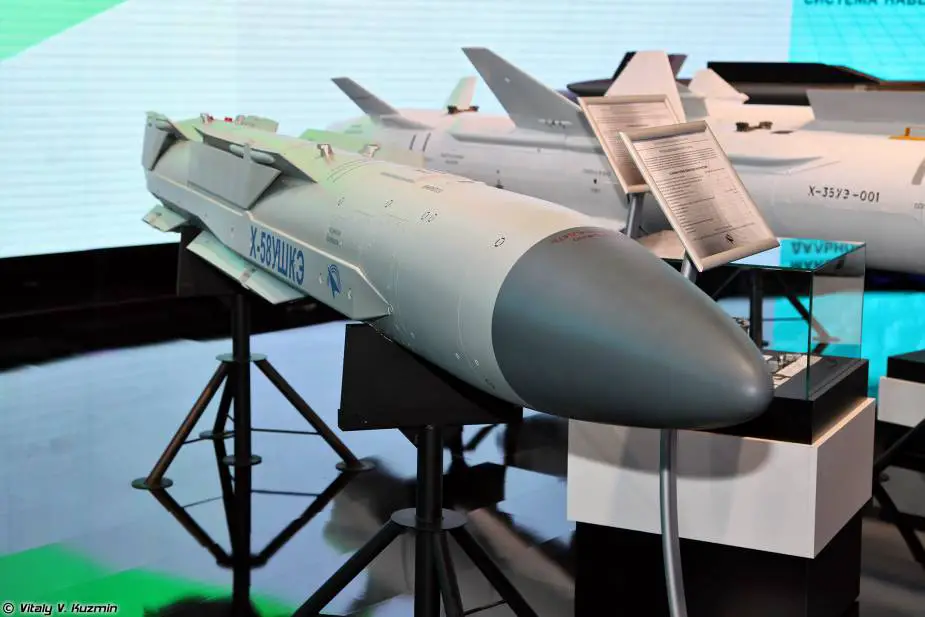-MOSCOW, August 29. /TASS-DEFENSE/. The United States handed over the second batch of HARM antiradar missiles to Ukraine. They are fit for MiG fighter jets operated by Kiev. A representative of the US Department of Defense said Washington wanted to provide to Ukraine an asymmetric and unexpected advantage.
Follow Army Recognition on Google News at this link

Kh-58UShKE anti-radiation missile displayed at MAKS airshow 2013 (Picture source: Vitaly Kuzmin)
The Russian Tactical Missiles Corporation (KTRV) produces several types of antiradar missiles for various carriers, while the Russian air defense intercepts US HARM. Defense Ministry Spokesman Igor Konashenkov said on August 19 two US missiles were downed in the Lugansk People’s Republic.
Kh-25MP
KTRV said Kh-25MP tactical antiradar missile destroys medium and short-range radars. Its onboard controls comprise the inertial navigation system and a multiband passive homing warhead. The payload is equipped with a non-contact detonation sensor. The range varies from 3 to 40 km. The maximum speed is 920 km/h and the launch weight is 315 kg.
The missile was designed by a modular scheme in the late 1970s to replace Kh-23M, Kh-25 and Kh-27PS. They belonged to the Kh-25M series with changeable guidance systems. The replacement of passive homing equipment on Kh-25M with a semi-active laser produced Kh-25ML. The absence of homing systems and installed radio command equipment resulted in Kh-25MR. The missiles were accepted into service in 1989 and became the backbone of Soviet air-to-surface missiles by the number and the carriers for them.
Kh-31
The Kh-31 family (NATO reporting name Krypton AS-17) comprises antiship and antiradar options. The Kh-31P is a high-speed antiradar missile with a passive radar homing warhead.
It destroys radars of medium and long-range air defense weapons, as well as ground and seaborne radars. “The homing warhead searches for and locks on the target on suspension under the aircraft by the data from the aircraft or autonomously. It tracks the target and creates data for missile guidance,” the KTRV said.
The missile is bigger and heavier than Kh-25MP. The launch weight is 600 kg with an 87-kg payload. The Kh-31P has a range of 110 km and develops a speed of 1000 m/sec.
Kh-31PK is a tactical precision missile with passive homing warheads. It is an upgrade of Kh-31P with a more effective payload and non-contact detonation sensor. The missile destroys radars with 15-meter high antennas of medium and long-range air defense weapons, as well as other ground radars. The warhead is tuned to the frequencies of modern air defense radars, as well as antiaircraft artillery operating in an uninterrupted impulse emission regime. The long flight range helps hit the targets without entering a hostile air defense zone. Supersonic speed and autonomous guidance provide an advantage to the carrier that can fire the missile from outside the range of the attacked antiaircraft weapon. Kh-31PK was designed for frontline aircraft. Its weight, speed, and distance are similar to Kh-31P.
Kh-31PD antiradar missile has twice a bigger range of 250 km as Kh-31PK. The guidance system is platformless inertial with broadband passive radar homing warhead. The universal cluster payload weighs 110 kg and the missile launch weight is 715 kg.
Krypton is the first missile in the world with a combined power plant — ramjet and solid-fuel booster. The missile can fly 3-5 meters above the ground at a speed of Mach 2 (over 2300 km/h). The high maneuverability increases the survivability of the missile against air defense and the effective destruction of the target in conditions of electronic warfare.
A source told TASS in July that Kh-31P was successfully engaged by Su-30SM fighter jets of the Black Sea fleet in Ukraine. The missiles confirmed effectiveness in strikes at Ukrainian military targets.
Kh-58E
The guided Kh-58E antiradar missile (export option of Kh-58) was designed to destroy radars of antiaircraft complexes, command posts, automatic guidance systems and radio-emitting targets in A, A’, B, B’ bands. It is an all-weather missile that does not fear rain, snow, or fog. The Kh-58E can be engaged at any time of the year in any latitude.
A-58E guidance system comprises a passive radar homing warhead and autonomous controls.
The Kh-58E is carried by Su-24MK, Su-22M4, Su-25TK, and MiG-25BM aircraft equipped with a catapult to release the missile. The maximum launch range depends on the release altitude and can reach 200 km at maximum speed. The launch weight is 650 kg and the payload weighs 149 kg.
Kh-58UShKE
Kh-58UShKE is one of the most perfect Russian antiradar missiles. It has broadband (combined A, A’, B, B’, and C bands) passive radar homing warhead and navigation and automatic controls of a platformless navigational system (BINS). Kh-58UShKE destroys ground radars operating in the impulse emission regime in the band of 1.2.11 GHz and in uninterrupted emission in the A band.
“The missile can be fired from the outside suspension of modern aircraft equipped with a guidance system and AKU-58 catapult, as well as from internal suspensions with UVKU-50 catapult. The missile destroys preset radars, as well as targets detected by the carrier aircraft,” KTRV said. The company added that Kh-58UShKE combat effectiveness exceeds that of Kh-58E 2.5 times.
The maximum range is 245 km. The missile develops a speed of 4200 km/h, which is several times faster than the speed of sound. The payload weighs 149 kg and the missile launch weight is 650 kg.
KTRV is the biggest Russian designer and producer of air, seaborne and ground tactical missiles. The company is 100 percent owned by the government and is headquartered in Korolev near Moscow. In its history, KTRV has created over 20 various types of missiles. It has designed Tsirkon hypersonic missile and is developing a supersonic BrahMos cruise missile together with India.
In late 2021 Russian President Vladimir Putin awarded the top national title of the Hero of Russia to KTRV CEO Boris Obnosov.














